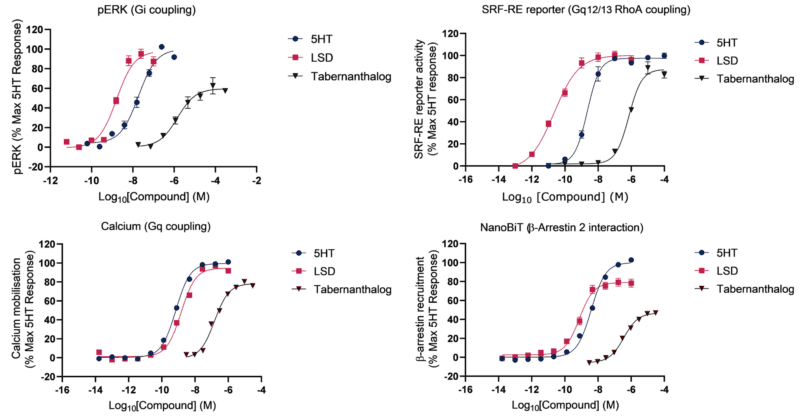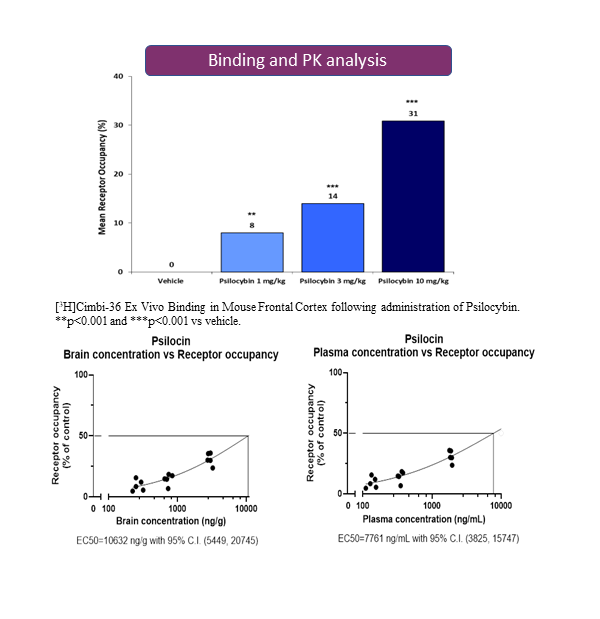Targeting the 5-HT2A receptor with psychedelics & novel molecules
Targeting the 5-HT2A receptor and other 5-HT receptors more generally has resulted in marketed drugs for various CNS disorders. In the last 5 years or so the interest in psychedelics as therapeutics has been pursued by multiple biotech companies for the treatment of depression, PTSD, substance abuse disorder, and other CNS disorders. Much of the focus has been on known psychedelics such as psilocybin, close analogues, and formulations thereof. However, beyond this, there is an increasing focus on novel chemical entities (NCEs).
DMPK – improving on current Psychedelic and close analogues
One key aim has been to maintain the therapeutic effect of known psychedelics but limit the length of the psychedelic experience, as this brings challenges for real-world treatment adoption. This requires extensive experience and capabilities in DMPK, particularly in how pharmacokinetic properties impact pharmacology. A close collaboration between Chemistry and DMPK allows a drug discovery team to generate SAR across a range of analogues of known psychedelics. This is also important in generating novel IP in a highly competitive space.
5-HT2A Receptor Modulation & Pharmacology – novel chemical entities and deeper understanding
Alongside the modulation of DMPK properties, it’s important to consider how analogues of known psychedelics and NCEs engage and modulate the 5-HT2A receptor, as this can also impact their therapeutic and side effect properties. Several approaches to modulating the 5-HT2A receptor that are potentially interesting to generate novel profiles include:
- Full agonism vs. partial agonism
- Affinity and on/off kinetics at the receptor
- Functional selectivity or biased cell signalling
- Orthosteric agonism vs. allosteric modulation
To understand drugs with these potential profiles you need:
- Cell line engineering capabilities to generate robust, reproducible, and reliable cell lines expressing 5-HT2A receptors and assays measuring G-protein, β-arrestin, and other effectors
- Access to a platform of biophysical assays including; SPR, MST, and others, that allow you to use the best assay to answer the question at hand
Moreover, it is unclear if engaging the 5-HT2A receptor alone is sufficient to drive a therapeutic response. Molecules with activities at a broader range of 5-HT receptors, or indeed other targets, is an additional poly-pharmacology approach that might be valuable
Downstream of 5-HT2A receptor modulation – confidence in therapeutic response
As a drug discovery project progresses and understanding of DMPK and primary 5-HT2A receptor modulation and pharmacology improves, it becomes clear that secondary, tertiary, and orthogonal assays are necessary to increase confidence, understand downstream effects, and predict therapeutic response. This includes:
- Cross-species differences – using cell lines and primary rodent/post-mortem human tissue
- Endpoints indicative of therapeutic response, mechanism, and side effects (in-vitro, ex-vivo, in-vivo assays), e.g. –
- Neuroplasticity – neurite outgrowth, molecular marker changes (e.g., egr1/2, PSD-95, synaptophysin)
- IPone accumulation/Ca2+ response – measured in-vitro, ex-vivo
- Head-twitch response in rodents – a potential predictor of hallucinogenesis
- Microdialysis – neurochemical profile of your NCE (monoamines, glutamate, GABA)
- Drug discrimination – a sensitive assay of hallucinogenesis and drug abuse
- Neuroinflammation (LPS-induced changes in brain cytokines, 1BA1, and TSPO)
- PK/PD, Biomarkers and Translatability
- Ex-vivo binding assays – e.g. [3H]-Cimbi-36, [3H]-MDL100,907, [3H]-UCB-J
- Functional Pharmacodynamic markers – mydriasis/miosis, body temperature, endpoints that can be assessed in rodents and early trials in man
- Biofluid biomarkers
5-HT2A presentations – Society for Neuroscience (SfN), Washington, November 11-15, 2023
At the SfN meeting, Sygnature Discovery and SB Drug Discovery will be showcasing some of the capabilities in the 5-HT2A/psychedelic space with two presentations.
A Cascade of binding and cell-based assays to characterize 5-HT2A receptor ligands and aid the investigation of signalling pathway bias (presentation: Gerrard et al.,)

This poster showcases a cascade of in vitro binding and cell-based assays measuring calcium mobilisation, β-arrestin interaction, receptor internalisation, and pERK levels. Psychedelic and non-psychedelic ligands were tested for their effect on these different downstream signalling effectors after binding to the receptor.
Hear more about this topic at Dr Davide Pau’s poster presentation on Monday, Nov 13th, 1-5 PM, PSTR310.01
Psilocybin: the relationship between head twitch response, locomotor activity, 5-HT2A ex vivo receptor occupancy and plasma and brain levels of psilocin (Cheetham et al.,)

This poster showcases our deep emphasis on PK/PD in all drug discovery projects. We show a correlation between ex vivo receptor occupancy, plasma and brain OK of psilocin, and behavioural response. Also, for ex vivo binding we used the agonist radioligand [3H]Cimbi-36 which labels the high affinity active state of the receptor. This is likely a more relevant binding assay than the antagonist radioligand [3H]MDL-100,907 when testing agonists.
Delve deeper into this topic at Dr Liz Jagger’s poster presentation on Tuesday, Nov 14th, 1-5 PM, PSTR426.16
So, does your 5-HT2A drug discovery platform have what it takes to identify and characterise psychedelics and novel 5-HT2A ligands?
Sygnature Discovery has deep expertise in drug discovery screening cascades, which enables us to follow the molecule further. Meet members of our team at the Society for Neuroscience (SfN) at Booth 932, to hear more about Sygnature Discovery’s capabilities.
